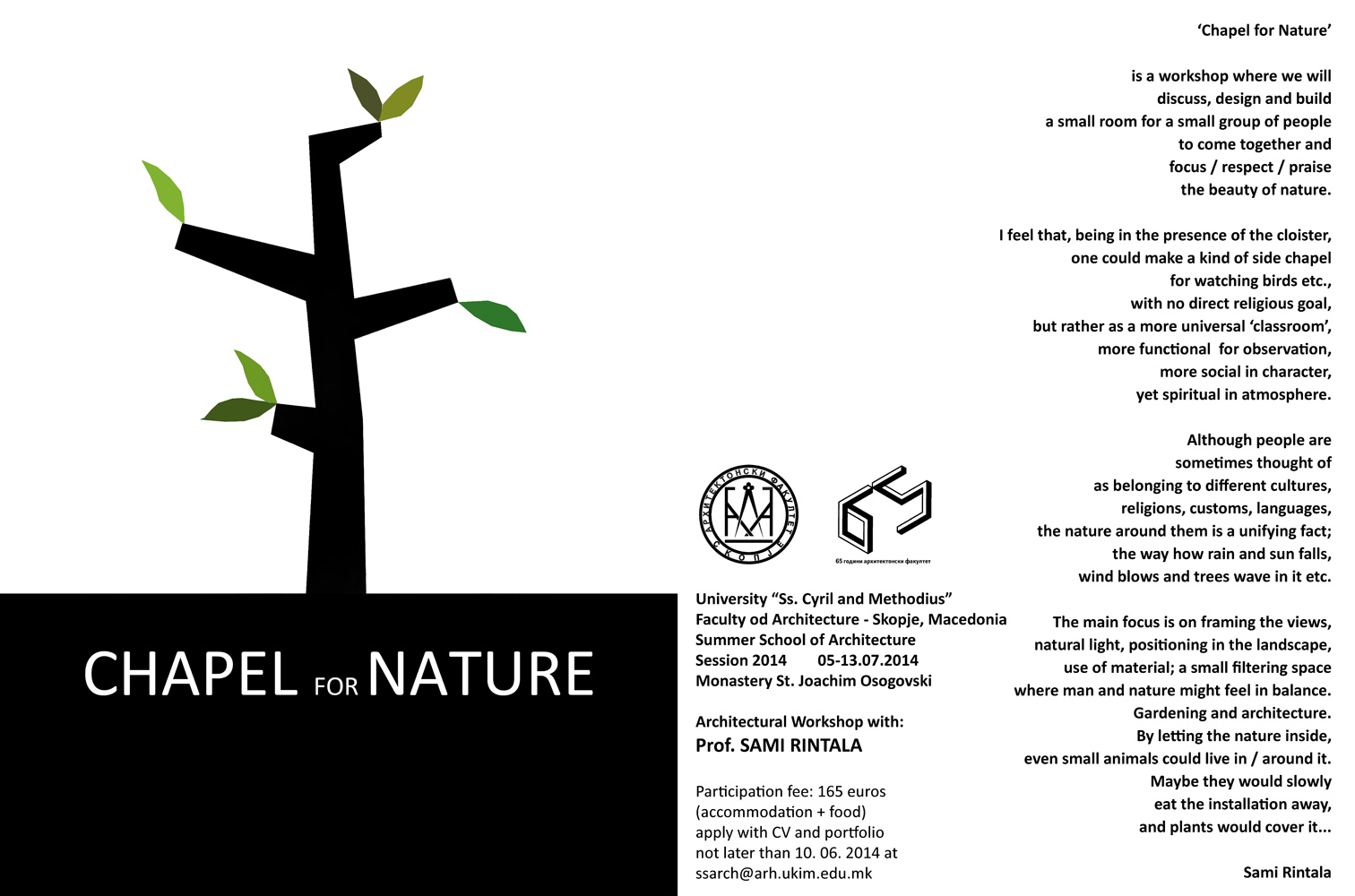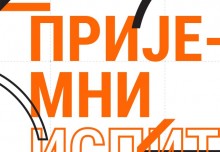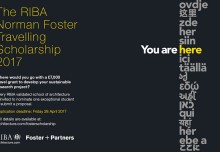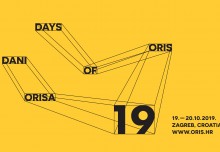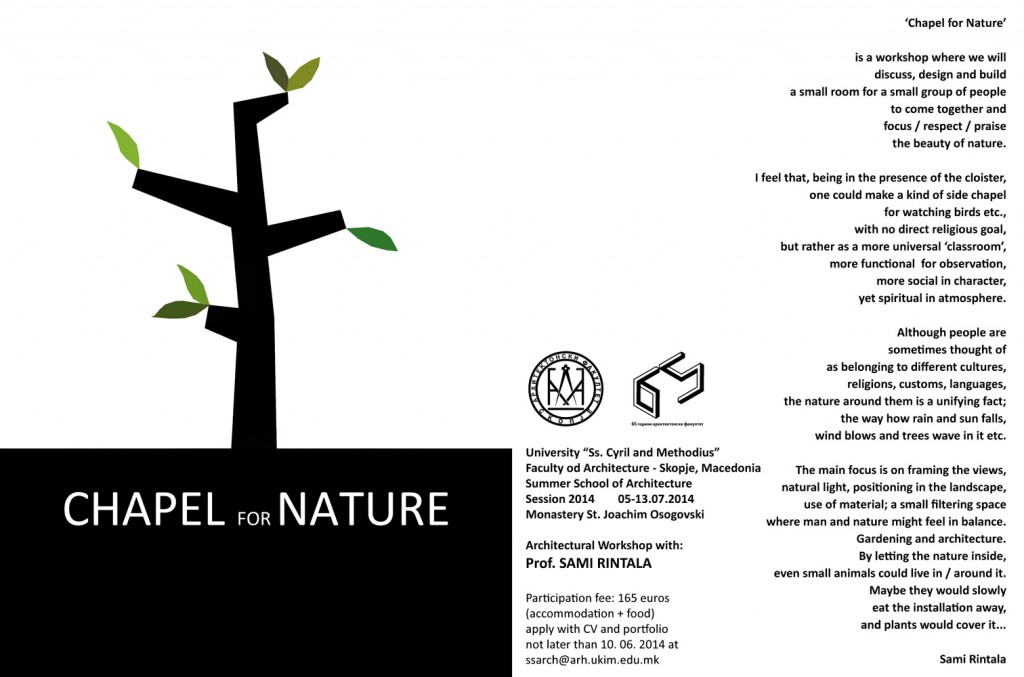Letnja škola
Produženo je prijavljivanje za Letnju školu arhitekture: KAPELA ZA PRIRODU (CHAPEL FOR NATURE).
Prijave možete poslati i posle 10. juna 2014.
Poziv na međunarodnu Letnju školu arhitekture 2014.
23. Letnja škola arhitekture
05-13. jul 2014.
Arhitektonski fakultet „Sv. Ćirilo i Metodije“ Univerziteta u Skoplju i ove godine tradicionalno organizuje međunarodnu Letnju školu arhitekture, koja će se održati od 5. do 13. jula 2014. godine u manastiru „Sv. Joakim Osogovski“ (100 km severo-istočno od Skoplja).
Tema ovogodišnje Letnje škole je KAPELA ZA PRIRODU (CHAPEL FOR NATURE). Gostujući predavač radionice Letnje škole je prof. Sami Rintala.
Arhitektonski fakultet „Sv. Ćirilo i Metodije“ poziva sve zainteresovane da se prijave za ovogodišnju radionicu Letnje škole.
Raspored
05.07.2014.
Dolazak učesnika u Skoplje u jutarnjim satima.
Prevoz iz Skoplja do Krive Palanke pre podneva.
Zvanično otvaranje Letnje škole arhitekture u večernjim satima.
05.07-13.07.2014.
Radionica.
12.07.2014.
Izložba i otvaranje Kapele za prirodu.
13.07.2014.
Odlazak učesnika i prevoz do Skoplja.
Prijava
Prijave se prihvataju i posle 10.06.2014. a na e-mail adresu ssarch@arh.ukim.edu.mk poslati sledeće:
- Biografija od maksimalno 5 strana A4 formata, PDF (sa fotografijom i e-mail adresom)
- Portfolio
Izabrani učesnici biće obavešteni do 15.06.2014. putem e-mail adrese.
Kotizacija
Kotizacija za ovogodišnju Letnju školu arhitekture iznosi:
5.000 mkd za studente Arhitektonskog fakulteta u Skoplju;
10.000 mkd (165 evra) za studente ostalih fakulteta arhitekture.
Kotizacija uključuje radionicu, smeštaj, hranu i prevoz na relaciji Skoplje – Kriva Palanka – Skoplje. Polaznici Letnje škole sami plaćaju troškove prevoza do Skoplja.
Više informacija
Više informacija o 23. Letnjoj školi arhitekture možete naći na sledećem linku:
http://ssarch.arh.ukim.edu.mk/
Opis radionice
“Chapel for Nature” is a workshop where we will discuss, design and build a small room for asmall group of people to come together and focus/ respect/ praise the beauty of nature.
I feel that, being in the presence of the cloister, one could make a kind of side chapel forwatching birds etc., with no direct religious goal, but rather as a more universal ‘classroom’, more functional for observation, more social in character, yet spiritual in atmosphere.
Although people are sometimes thought of as belonging to different cultures, religions, customs, languages, the nature around them is a unifying fact; the way how rain and sun falls, wind blows andtrees wave in it etc.
The main focus is on framing the views, natural light, positioning in the landscape, use of material;a small filtering space where man and nature might feel in balance. Gardening and architecture. By letting the nature inside, even small animals could live in / around it. Maybe they would slowly eat the installation away, and plants would cover it…
Sami Rintala

Biografija gostujućeg predavača
Sami Rintala (born 1969) is an architect and an artist, with a long merit list after finishing his architect studies in Helsinki Finland 1999. He established architect office “Casagrande & Rintala” 1998, which produced a series of acknowledged architectural installations around the world during the next five years until 2003. These works combine architecture with critical thinking of society, nature and the real tasks of an architect, all within a cross-over art field using space, light, materials and human body as tools of expression.
Rintala had his first wider recognition in 1999 with the project Land(e)scape: Three abandoned wooden barns were raised on 10 meter high legs to follow their farmers to the cities as a critical comment on the deserting process of the countryside. In Venice Biennale 2000 Sixty Minute Man was realized; A ship sailed to Arsenal with a garden inside. The park was planted on sixty minutes of human waste from the city of Venice, becoming together with the old boat a three dimensional collage of society waste commenting on the Biennale theme “less aesthetics, more ethics”.
In 2008, Rintala started a new architect office with Icelandic architect Dagur Eggertsson, called Rintala Eggertsson Architects. The office is based in Oslo, South Norway and Bodø, North Norway.
Important part of Rintala’s work is teaching and lecturing in various art and architecture universities. Teaching takes place usually in form of workshops where the students often are challenged to participate the shaping of human environment on a realistic 1:1 situation.
Sami Rintala’s work is based on narrative and conceptualism. Resulting work is a layered interpretation of the physical, mental and poetic resources of the site.

